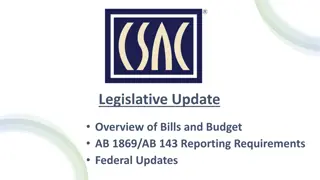
Advanced Concepts in Zero-Knowledge Proofs
Explore the evolution of zero-knowledge proofs, from the introduction by Goldwasser, Micali, and Rackoff in 1985 to modern techniques like Sahai-Waters NIZK and unique proofs. Discover the implications of removing interaction in proofs and the quest for unique accepting proofs.
Download Presentation

Please find below an Image/Link to download the presentation.
The content on the website is provided AS IS for your information and personal use only. It may not be sold, licensed, or shared on other websites without obtaining consent from the author. If you encounter any issues during the download, it is possible that the publisher has removed the file from their server.
You are allowed to download the files provided on this website for personal or commercial use, subject to the condition that they are used lawfully. All files are the property of their respective owners.
The content on the website is provided AS IS for your information and personal use only. It may not be sold, licensed, or shared on other websites without obtaining consent from the author.
E N D
Presentation Transcript
Unique NIZKs Unique NIZKs and and Steganography Steganography Detection Detection W I L L Y W I L L Y Q U A C H Q U A C H , , L A K Y AH T Y N E R L A K Y AH T Y N E R , , A N D D A N I E L A N D D A N I E L W I C H S W I C H S
Motivation Motivation Zero-knowledge proofs were introduced in 1985 by Goldwasser, Micali and, Rackoff ? ?? ?? ? ????? ???
Motivation Motivation Zero-knowledge proofs were introduced in 1985 by Goldwasser, Micali and, Rackoff ? ?? ?? ? ????? ???
Motivation Motivation Zero-knowledge proofs were introduced in 1985 by Goldwasser, Micali and, Rackoff ? ?? ?? ? ????? ??
Motivation Motivation What if we remove interaction? Blum, Feldman, and Micali 1988 tells us we need a ??? ??? ? ?? ?? ??? ?? ??? [BFM88, FLS90, CHK03, GOS06, CCH+19, PS19]
Motivation Motivation Sahai-Waters NIZK (from iO) has a deterministic prover ??? ? ?? ?? ??? So the prover send the same proof for a given statement
Motivation Motivation Adversary could find a different proof that the verifier accepts ??? ? ?? ?? ??? ? ?? ?? ??
Motivation Motivation Could there exists only a single unique accepting proof for a statement ?? ??? ? ?? ?? ???
Motivation Motivation Uniqueness implies witness encryption, even when the prover is honest and even without ZK ??? ? ?? ?? ??? ? ? We can convert Sahai-Waters proof into a unique proof using injective OWF
The Model and Our Results The Model and Our Results We consider a version of unique zero-knowledge proofs (UNIZKs) [Lepinski, Micali, shelat 05] with the following two relaxations: Stat. unique proofs proofs ? for NP languages with comp. unique witnesses witnesses ? 1. Any malicious ? who can produce accepting ? ? for ? also knows valid ? ? UNIZKs with prover setup. Given a ??? the prover samples random (??,??) 2. ?? is used to generate proofs for arbitrarily many statements. Once ?? is fixed, subsequent proofs are unique * We show that removing either relaxation implies witness encryption
The Model and Our Results The Model and Our Results Assuming the hardness of Learning with Errors (LWE), we build multi- theorem Unique NIZKs (UNIZKs) for NP satisfying adaptive* soundness/uniqueness/zero-knowledge. *Adversary can see the ??? before choosing statement
Prior Work Prior Work Fair Zero-Knowledge [Lepinski, Micali, shelat 05] Essentially equivalent definition of uniqueness but they achieve UNIZKs under Quadratic Residuosity Open question to get UNIZKs from other assumptions Steganography Free Zero Knowledge (SF-ZK) [Abdolmaleki et al. 22] Similar definition but interactive proof and interactive setup between P and V
Application: Steganography Detection Application: Steganography Detection Consider a server that generates DSA signatures
Application: Steganography Detection Application: Steganography Detection If the server is compromised then it could leak information about ?? steganographically The signatures are randomized so the server could intelligently choose which signatures to send
Application: Steganography Detection Application: Steganography Detection Authority sets up a PRF Server uses a UNIZK to prove that randomness used is from PRF
Recall: Recall: Multi-theorem UNIZK satisfying adaptive soundness/uniqueness/zero-knowledge against maliciously generated keys
Recall: Recall: Multi-Single theorem UNIZK satisfying adaptive soundness/uniqueness/zero-knowledge against maliciouslyhonestly generated keys
Single Theorem UNIZK with Honest Prover Setup Single Theorem UNIZK with Honest Prover Setup ?
Single Theorem UNIZK with Honest Prover Setup Single Theorem UNIZK with Honest Prover Setup ? {0,1} ?
Single Theorem UNIZK with Honest Prover Setup Single Theorem UNIZK with Honest Prover Setup ??? ? {0,1} ?
Single Theorem UNIZK with Honest Prover Setup Single Theorem UNIZK with Honest Prover Setup ?? ? {0,1} ?
Single Theorem UNIZK with Honest Prover Setup Single Theorem UNIZK with Honest Prover Setup ?? ?,? ? ? commitments to labels
Single Theorem UNIZK with Honest Prover Setup Single Theorem UNIZK with Honest Prover Setup ?? *permuted for ? ?,? ? } ?? = { , , commitments to garbling randomness commitments to labels ?? = { } , openings to labels openings to garbling randomness
Single Theorem UNIZK with Honest Prover Setup Single Theorem UNIZK with Honest Prover Setup ?? ?,? Opening to labels for ?||?
Single Theorem UNIZK with Honest Prover Setup Single Theorem UNIZK with Honest Prover Setup ? } ?? = { , , ?? commitments to garbling randomness commitments to labels Opening to labels for ?||? correspond? and openings labels (?,?) ? {0,1}
Proof Intuition Proof Intuition *permuted for ? } ????? = { ? } ?? = { , , Opening to labels for ?||? commitments to garbling randomness commitments to labels Soundness follows from binding of commitments and correctness of garbling Uniqueness holds as long as commitments have statistically unique openings Zero-Knowledge follow from hiding of the commitments
Recall: Recall: Multi-Single theorem UNIZK satisfying adaptive soundness/uniqueness/zero-knowledge against maliciouslyhonestly generated keys
Recall: Recall: Multi-theorem UNIZK satisfying adaptive soundness/uniqueness/zero-knowledge against maliciouslyhonestly generated keys
Transformation to Multi Transformation to Multi- -theorem: Take 1 theorem: Take 1 Similar to transformation from one Similar to transformation from one- -time to many time to many- -time signatures time signatures (??,??) (??0,??0) (??1,??1) (??01,??01) (??00,??00) (??10,??10) (??11,??11) . . . . . .
Transformation to Multi Transformation to Multi- -theorem: Take 1 theorem: Take 1 Similar to transformation from one Similar to transformation from one- -time to many time to many- -time signatures time signatures commitment to PRF (??0,??0) Madre (??01,??01) Ni a (??00,??00) Ni o Generates ??00,??00 and (??01,??01) Proves that task #1 is done wrt a committed PRF key using single theorem UNIZK
Transformation to Multi Transformation to Multi- -theorem: Take 1 theorem: Take 1 Similar to transformation from one Similar to transformation from one- -time to many time to many- -time signatures time signatures (??,??) commitment to PRF (??0,??0) (??1,??1) . . . . . . (??01,??01) (??00,??00) (??10,??10) (??11,??11) (???,???)
Transformation to Multi Transformation to Multi- -theorem: Take 1 theorem: Take 1 Similar to transformation from one Similar to transformation from one- -time to many time to many- -time signatures time signatures (??,??) commitment to PRF (??0,??0) (??1,??1) . . . . . . (??01,??01) (??00,??00) (??10,??10) (??11,??11) (???,???)
Multi Multi- -theorem: Take 1 Summary theorem: Take 1 Summary Similar to transformation from one Similar to transformation from one- -time to many time to many- -time signatures time signatures ????? ???? (??,??) ?? = { } ?,? (???,???) commitment to PRF ? (??0,??0) Single theorem UNIZK (??01,??01) s? = { ? } , opening for ? commitment (???,???) The security of the parent single theorem proofs ensures soundness + uniqueness of the child proofs
Issue with previous attempt Issue with previous attempt Recall that ?? for single theorem proof includes garbled ? which grows with ||?|| *permuted for ? ? } ?? = { , , commitments to garbling randomness commitments to labels
Issue with previous attempt Issue with previous attempt | generated child keys using ? | = ? | generated child keys using ? | = ?
Issue with previous attempt Issue with previous attempt | generated child keys using ? | = ? |??0| | generated child keys using ? | = ? |??1|
Issue with previous attempt Issue with previous attempt ?? ??0 + ??1 2? | generated child keys using ? | = ? |??0| | generated child keys using ? | = ? |??1|
Issue with previous attempt Issue with previous attempt ?? ??0 + ??1 2? | generated child keys using ? | = ? |??0| | generated child keys using ? | = ? |??1| Need a single-theorem UNIZK that can prove statements about setup efficiently Use FHE to get one with fixed key size for arbitrary statements
Recall: Recall: Multi-theorem UNIZK satisfying adaptive soundness/uniqueness/zero-knowledge against maliciouslyhonestly generated keys
Recall: Recall: Multi-theorem UNIZK satisfying adaptive soundness/uniqueness/zero-knowledge against maliciously generated keys
Multi Multi- -theorem with Malicious Keys theorem with Malicious Keys ????? (??,??) (??0,??0) (??1,??1) (??01,??01) (??00,??00) (??10,??10) (??11,??11) . . . . . .
Summary Summary Defining UNIZKs Application for Steganography Detection Constructed Single-theorem UNIZKs Constructed Multi-theorem UNIZKs from Single-theorem Constructed Multi-theorem UNIZKs with malicious keys
Proof Intuition for Multi Proof Intuition for Multi- -theorem theorem
Proof Intuition: Multi Proof Intuition: Multi- -theorem Zero Knowledge theorem Zero Knowledge ????? ???? (??,??) ?,? ?? = { } {???}? , (???,???) commitment to PRF ? (??0,??0) (??01,??01) Single theorem UNIZK s? = { } ? {???}? , , (???,???) opening for ? commitment
Proof Intuition: Soundness Proof Intuition: Soundness ????? ???? (??,??) pseudo ?,? ?? = { } {???}? , (???,???) commitment to PRF ? (??0,??0) pseudo (??01,??01) pseudo Single theorem UNIZK s? = { } ? {???}? , , (???,???) pseudo opening for ? commitment
Proof Intuition: Uniqueness Proof Intuition: Uniqueness (??,??) (??,??) ?,? ?,? (???,???) (???,???) (??0,??0) (??0,??0) (??01,??01) (??01,??01) Single theorem UNIZK Single theorem UNIZK (???,???) (???,???) Proof #1 Proof #2
Proof Intuition: Uniqueness Proof Intuition: Uniqueness (??,??) (??,??) ?,? ?,? (???,???) (???,???) (??0,??0) (??0,??0) (??01,??01) (??01,??01) Single theorem UNIZK Single theorem UNIZK (???,???) (???,???) Proof #1 Proof #2
Proof Intuition: Uniqueness Proof Intuition: Uniqueness (??,??) (??,??) ?,? ?,? (???,???) (???,???) (??0,??0) (??0,??0) (??01,??01) (??01,??01) Single theorem UNIZK Single theorem UNIZK (???,???) (???,???) Proof #1 Proof #2
Proof Intuition: Uniqueness Proof Intuition: Uniqueness statement = generated child keys using ? statement = generated child keys using ? witness = {?, witness = {?, } } opening for ? commitment opening for ? commitment Proof #1 Proof #2






















